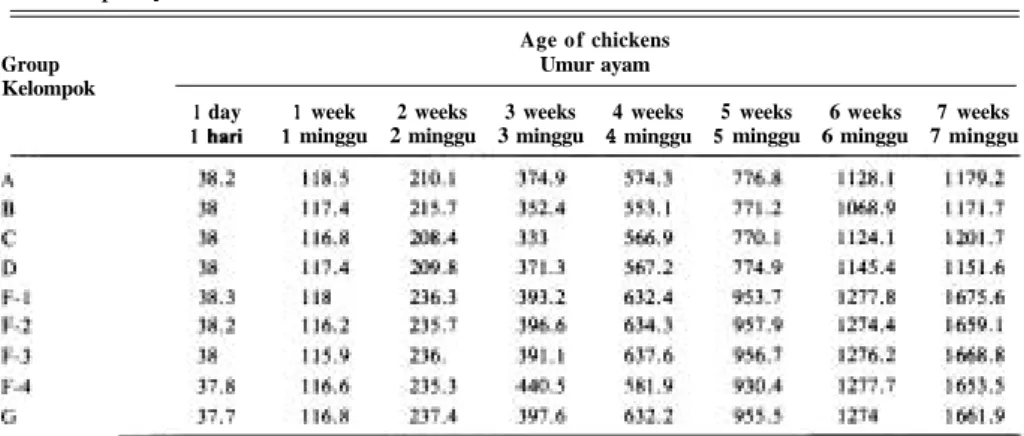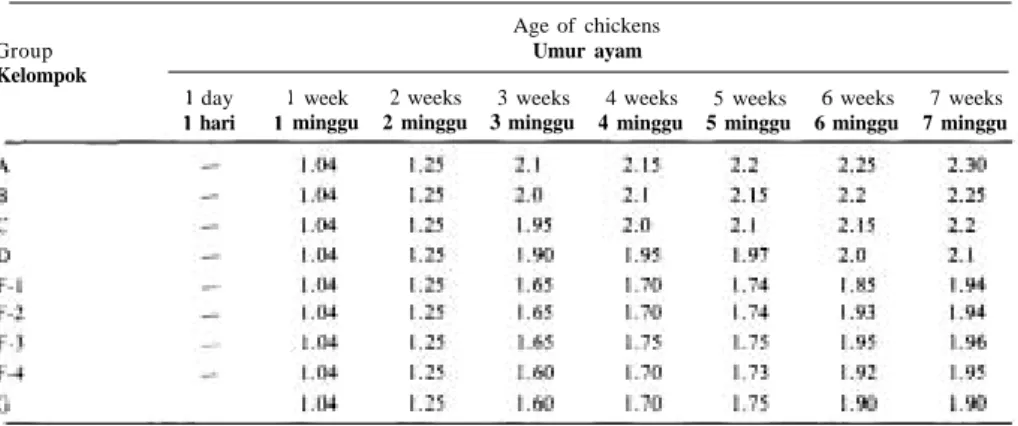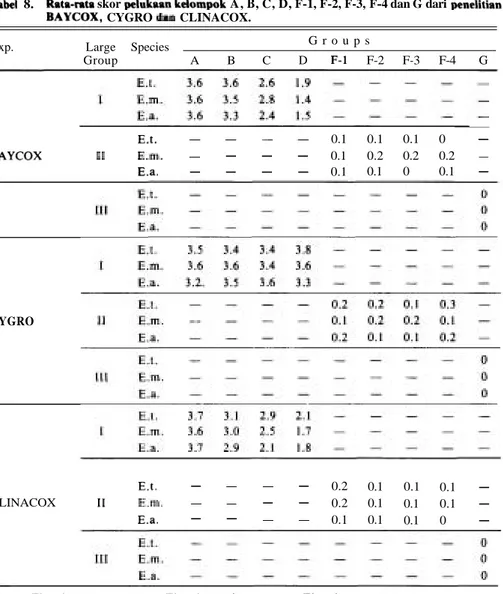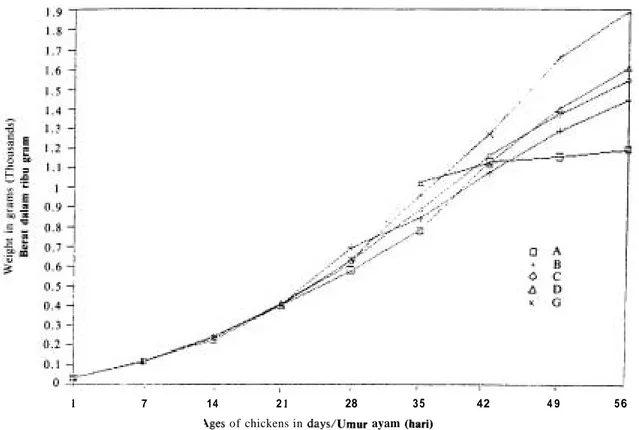Forum Pascasarjana (1990) 13 (2): 29-44.
EFFICACY EVALUATION OF SOME COCCIDIOSTATS AS CHICKENS COCCIDIOSIS CONTROL AGAINST
LOCAL STRAIN IN INDONESIA"
(Pengkajian efektivitas beberapa koksidiostat sebagai pencegah koksidiosis pada ayam yang disebabkan oleh
coccidia galur lokal di Indonesia)
Gatut Ashadiz'
ABSTRAK
Seribu delapan ratus ekor anak ayam umur sehari Starbro-broiler digunakan dalam tiga peneli- tian ini, 450 ekor untuk penelitian BAYCOX, 450 ekor untuk penelitian CYGRO dan 900 ekor un- tuk penelitian CLINACOX. Ketiga penelitian ini bertujuan untuk mengkaji efektivitas koksidiostat- koksidiostat itu dengan parameter internasional yang digunakan oleh Reid (1970) yaitu mortalitas, skor pelukaan, pertambahan berat badan rata-rata dan konversi makanan.
Hasil penelitian menunjukkan bahwa pada kelompok anak ayam yang tidak ditambahkan kok- sidiostat dalam makanan atau air minumnya terjadi kematian antara 19%-76% setelah ditantang, sedangkan pada kelompok anak ayam yang mendapatkan tambahan koksidiostat dalam makanan atau air minumnya tidak terjadi kematian setelah ditantang. Pertambahan berat badan pada kelom- pok anak ayam yang tidak menerima tambahan koksidiostat lebih kecil dari ayam kontrol, sedang- kan pada anak ayam yang menerima tambahan koksidiostat tampak sama atau sedikit lebih dari ayam kontrol setelah ditantang. Pada kelompok anak ayam yang mendapat tambahan koksidiostat skor pelukaan menunjukkan tidak terjadinya koksidiasis atau koksidiosis, sedangkan pada kelom- pok anak ayam yang tidak mendapat tambahan koksidiostat menunjukkan terjadinya koksidiosis atau koksidiasis setelah ditantang. Konversi makanan pada anak ayam yang tidak mendapatkan tam- bahan koksidiostat menunjukkan efektifitas mengubah makanan lebih kecil dari ayam kontrol, se- dangkan pada kelompok anak ayam yang mendapatkan koksidiostat konversi makanan kurang le- bih sama dengan ayam kontrol setelah ditantang.
INTRODUCTION
Coccidiosis is a parasitic disease caused by unicelluler animals belonging to the phylum Protozoa. The disease is one of many kinds causing problem and loss to chicken farms. The loss caused by it comprises mortalities, decrease of body weight, delay of egg production and low egg production, decrease of feed conversion and increase of medical cost, labour cost, etc. Since the loss can pre- vent or even discourage the development of chickens farms, which consequently
" Pengkajian terhadap koksidiostat BAYCOX dari PT. Bayer Indonesia, CYGRO dari American Cyanamid Company dan CLINACOX dari PT. Squibb Indonesia.
2' Ketua Laboratorium Protozoologi Fakultas Kedokteran Hewan IPB dan Ketua Program Studi Sains Veteriner, Program Pascasarjana IPB.
also inhibit the government's effort to increase animal protein production, it is desirable to endeavour control measures against coccidiosis in chickens.
There are two forms of coccidiosis in chickens: Caecal coccidiosis caused by Eimeria tenella and intestinal coccidiosis caused by. E. necatrix, E. maxi-
ma, E. brunetti, E. acervulina, E. praecox, E. mitis and E. mivati. Beside that
E. tenella can extends the zone of infection to caudal part of intestine, rectum,
and according to Anderson et al. (1976) could infect the bursa of Fabricii. Single species infection was very seldom in the chickens farms, usually mixed infection occured. In Indonesia five species of coccidia had been isolated since 1967 by Prastowo, Ashadi and Soekardono namely: E. tenella, E. necatrix, E. maxima,
E. acervulina and E, mitis. Ashadi (1979) determined accurately the local strains
of Eimeria tenella, while Cahyaningsih (1986) studied carefully about pathoge-
nicity of Eimeria acervulina.
Up to the present, coccidiosis control in chickens in Indonesia is generally done by applying sanitation measures or by adding coccidiostat to the feed or drink of the chickens, while administration of imported coccidia vaccine has been tried only on several chickens farm industries. The tiny size of oocyst that enables it to be carried away by wind, dust, water, feed, drink, farm tools, labourers or people coming and leaving the farm, makes the hygienic method rather inefficient. On the other hand coccidiosis control by adding coccidiostat in the feed or drink requires careful handling and accurate doses so as not to cause side effects. Therefore all kinds coccidiostat that imported to Indonesia requires careful efficacy evaluation before distributed to the chickens farms.
In this experiment Laboratory of Protozoology, Department of Parasitol- ogy and Pathology, Faculty of Veterinary Medicine, Bogor Agricultural Univer- sity evaluated BAYCOX, CYGRO and CLINACOX coccidiostat as anticocci- dial drugs against local strains of chickens coccidia. The species that will be used in this experiment are E. tenella, E. maxima and E. acervulina. E. tenella is the most pathogenic caecal coccidiosis, while E. maxima and E, acervulina is not so pathogenic but economically disturbance. According to Reid (1970) the excel- lent parameters used for efficacy judgment are mortality, lesion scores, average weight gains and feed conversion.
METHODOLOGY
Each coccidiostat has three large groups of two-weeks old chickens which free coccidial infection were used in this experiment, which comprises Large group I consist of four groups. Each of the group (A, B, C, D) composed of 50 chickens for Baycox and Cygro but 100 chickens for Clinacox. In the group A each chicken was infected with 200,000 oocysts of E. tenella. 600,000 oocysts of E. maxima
and 750,000 oocysts of E. acervulina. In the group B each chicken was infected with 150,000 oocysts of E. tenella, 400,000 oocysts of E. maxima and 500,000 oocysts of E. acervulina. In the group C each chicken was infected with 100,000
oocysts of E. tenella, 200,000 oocysts of E. maxima and 250,000 oocysts of E. acervulina. In the group D each chicken was infected with 50,000 oocysts of E. tenella, 100,000 oocysts of E. maxima and 125,000 oocysts of E. acervulina. No
drug given to the chickens in the large group I. The large group I1 composed of same four groups F-1, F-2, F-3 and F-4, which were infected with occysts E. tenella, E. maxima and E. acervulina same doses like group A, B, C, and D.
Anti coccidial drugs BAYCOX was given 24 hours after infected through the drinking water with the dose 50 ppm during two days, CYGRO was given 48 hours before infected with the dose 5 ppm in the chickens feed continously until the end of the experiment, and CLINACOX was given with the dose 0.83 ppm in the feed since one-day old continously until the end of the experiment. The large group I11 is the control. Chickens in this group were not infected at all and also no drug were given.
The parameter used for efficacy judgment in this experiment were mortali- ty, lesion scores, average weight gains and feed conversion. The experiment con- ducted until 8 weeks for BAYCOX, 7 weeks for CYGRO and CLINACOX.
The schematic design of the experiment as follows.
Large Groups Amount of Dosis of infection
group chickens
A
-
x/y/z-
200,000 oocysts E. tenella 600,000 oocysts E. maxima 750,000 oocysts E. acervulina 150,000 oocysts E. tenella(2 weeks old) 400,000 oocysts E. maxima 500,000 oocysts E. acervulina
INFECTED 100,000 oocysts E. tenella
200,000 oocysts E. maxima
DRUG 250,000 oocysts E. acervulina
D
-
50,000 oocysts E. tenella (2 weeks old) 100,000 oocysts E. maxima125,000 oocysts E. acervulina I I F-4 x = BAYCOX = 50 chickens Y = CYGRO = 50 chickens z = CLINACOX = 100 chickens 111
-
G -x/y/z (2 weeks old) CONTROL NOT INFECTED NO DRUGChickens and Cages
Before the experiment started, single-cell isolation and oocysts reproduc- tion were done and the chickens used in these experiments were Starbro-broiler. Special cages completed with feed and water cups were used during three weeks (one-day old until 21-days old). Each cage contain three chickens. After three weeks the chickens transfered to the floor-pen experiment rooms until 7 or 8 weeks old. On one-day old and every week the chickens were weighted.
Chickens Feed and Water Consumption
The feed which given to the chickens from one-day old until four-weeks old was Broiler Starter (BS = BRI).
The composition of the feed :
Maximum Water : 14.0%
Maximum Gross protein : 21.0% Maximum Gross Fat : 3.0% Maximum Gross Fiber : 4.0%
Maximum Ashes : 5.5%
Broiler Finisher (BF = BR2-1) were given to the four-week old chickens until the end of the experiment, which had composition :
Maximum Water : 14.0%
Maximum Gross protein : 19.0% Maximum Gross Fat : 4.0% Maximum Gross Fiber : 4.0%
Maximum Ashes : 5.0%
Feed and water were given et libitum and the consumption every day always
were noted.
Oocysts of Coccidia
A virulent local strain of E. tenella, moderate pathogenis of E. maxima and slight pathogenic of E. acervulina, which isolated since 1968 from Jakarta, Bogor, Bandung, Semarang, Purwokerto, Yogyakarta, Surabaya, Malang and Banyuwangi were used for inoculation in these experiments. Pure strains was acquired by single-cell isolation technique, in the three successive passages. The oocysts obtained were used for reproduction of oocysts and the oocyst obtained were then used as inoculum.
Lesion Scoring Techniques
Seventh day after inoculation of the three species coccidia: E. tenella, E.
ten chickens of CLINACOX experiments in the group (A, B, C, D, F-1, F-2, F-3, F-4 and G) were dissected and the lesion score evaluation according to
Johnson and Reid (1970) were assessed.
RESULT AND DISCUSSION
Mortality
The mortality (%) which occur in the BAYCOX, CYGRO and CLINACOX
experiments were tabulated in the Table 1 indicated that there were no chickens died in the groups which received those drugs within the feed or the drinking water after challenged same as the control group. While in the group which didn't receive any drugs the mortality occur between 19%-76% after challenged.
Table 1. The mortality (Yo) occur in the BAYCOX, CYGRO and CLINACOX experiments. Tabel 1. Persentase mortalitas pada penelitian BAYCOX, CYGRO dan CLINACOX.
G r o u p s
Experiments Large group Kelompok
Penelitian Kelompok besar
A B C D F-1 F-2 F-3 F-4 G BAYCOX I I1 111 CYGRO 1 I I I11 CLINACOX 1 I I I11
The Average Weight Gains
The average weight gains which tabulated in the Table 2, 3 and 4 indicated
that the survivour chickens in the groups A, B, C and D had less average weight gains than the control group G. But the chickens in the group F-1, F-2, F-3 and
F-4 had same or little more average weight gains than the control group G.
According to Dunnett's t test at confidence level 95% the difference between the average weight gains of the groups A, B, C, D with control group G on the
seven weeks old chickens were significance. But the difference between the average weight gains of the group F-1, F-2, F-3, F-4 with control group G on
the seven weeks old chickens were not significance. The graphs showed in the figure 1 , 2, 3, 4, 5 and 6 indicated clearly about the growth comparison of those groups after challenged.
Table 2. The growth average of the body weight (in grams) o f Groups A . B, C. D, F-I, F-2, F-3, F-4, and G Chickens in the BAYCOX experiment.
Tnbel 2. Rntn-rnln pertumbuhnn bernt bndnn (grnm) nynm dnri kelompok A, B, C, D, F , . F 2 . F j , F 4 dun G pndn penelltian BAYCOX. Group Kdompok I day 1 hnri Age of chickens Umur nynm
l week 2 weeks 3 weeks 4 weeks 5 weeks 6 weeks 1 minggu l minggu 3 minggu 4 minggu 5 minggu 6 minggu
7 weeks 8 weeks 7 minggu 8 minggu
Table 3. The growth average of the body weight (in grams) of Groups A, B, C, D, F-I, F-2, F-3, F-4, and G
Chickens in the CYGRO experiment.
Tabel 3. Ratn-rata pertumbuhan berat badan (gram) ayam dari kelompok A, B, C, D, F1, F2, F3, Fq dan G
pada penelitian CYGRO.
Age o f chickens
Group Umur ayam
Kelompok
l day l week 2 weeks 3 weeks 4 weeks 5 weeks 6 weeks 7 weeks
Table 4. The growth average of the body weight (in grams) of groups A, B, C, D, F-I, F-2, F-3, F-4 and G in the CLINACOX experiment.
Tnbel 4 . Rnta-rnm pertumbuhnn bernt badan (gram) ayam dari kelompok A, B, C, D, E l , F2. F3, F q dnn G
padn penelitinn CLINACOX.
Age of chickens
Group Umur nynm
Kelompok
l day l week 2 weeks 3 weeks 4 weeks 5 weeks 6 weeks 7 weeks
1 ban 1 minggu 2 minggu 3 minggu 4 minggu 5 minggu 6 minggu 7 minggu
A 38.187 118.82 226.94 384.76 579.919 778.438 1022.12 1199.52
B 38.069 119.17 233.672 400.156 606.769 848.769 1077.28 1296.88
The Feed Conversion
The feed conversion of the chickens in the group A, B, C and D which showed in the Table 5, 6, and 7, indicated more than the control group G, but feed conversion of the chickens in the groups F-I, F-2, F-3, and F-4 were more or less same as the control group G. According to Dunnett's t test at confidence level 95% the difference between the feed conversion of the chickens in the groups A, B, C, D with control group G on the 3, 4, 5, 6 and 7 weeks old were signifi- cance. But the difference between the feed conversion of the chickens in the group F-1, F-2, F-3, F-4 with the control group G on the 3, 4, 5, 6 and 7 weeks old were not significance. So the chickens in the group A, B, C and D were less effective to converse feed that the control or normal chickens, but the chickens in the group F-1, F-2, F-3 and F-4 were same effective as the control or normal chickens.
Table 5. The feed conversion o f ch~ckens In group A. B. C, D, F-I, F-2, F-3, F-4 and C (BAYCOX Experiment).
Tnbel 5. Konversi m s k n l ~ n n nYsm kelompok A , B, C, D, F1. F2, F3, F4 dnn G (Penelitinn BAYCOX).
Age o f chickens
Group Umur nysm
Kelompok
1 day l week 2 weeks 3 weeks 4 weeks 5 weeks 6 weeks 7 weeks 8 weeks I hsri I minggu 2 minggu 3 minggu 4 minggu 5 minggu 6 minggu 7 minggu 8 minggu
A - 1.04 1.25 2.03 2.09 2.14 2.21 2.24 2.3 El - 1.04 125 1.97 2.08 ? . I 2 2.18 2.21 2.24 C - 1 04 1.25 1.87 2.02 2.07 2 11 2.2 2.21 D - 1.04 1.25 1.76 1.95 2.05 2.1 2.17 2.19 F- l - 1.04 1.25 1.48 1.63 1.76 1.85 1.93 2.01 F-2 - 1.04 1.25 1.49 1.66 1.74 1.84 1.94 2.02 F-3 - 1.04 1.25 1.51 1.65 1.74 1.83 1.96 2 F-4 - 1.04 1.25 1.5 1.65 1.73 1.85 1.94 2 G - 1 04 1.25 1.5 1 65 1.75 1.84 1.95 2.01
Table 6. The feed conversion of chickens In group A, B, C, D, F-I, F-2, F-3, F-4 and G (CYGRO Experiment).
Table 6. Konversi makanan ayam kelompok A, B, C, D, F1, Fq, F3, Fq dan G (Penelitian CYGRO).
Age of chickens
Group Umur ayam
Kelompok
l day l week 2 weeks 3 weeks 4 weeks 5 weeks 6 weeks 7 weeks
1 hari 1 minggu 2 minggu 3 minggu 4 minggu 5 minggu 6 minggu 7 minggu
Table 7. The feed conversion of chickens in group A, B, C, D, F-I, F-2. F-3, F-4 and G (CLINACOX Experi- ments).
Tabel 7. Konversi makanan pada ayam kelompok A, B, C, D, F1, F2, F3. Fq dan G (Penelitian CLINACOX).
Age of chickens
Group Umur ayam
Kelompok
l day 1 week 2 weeks 3 weeks 4 weeks 5 weeks 6 weeks 7 weeks
1 hari 1 minggu 2 minggu 3 minggu 4 minggu 5 minggu 6 minggu 7 minggu
The Lesion Score
The average of lesion scores in the group A, B, C, D, F-I, F-2, F-3, F-4
and G of the BAYCOX, CYGRO and CLINACOX experiments were tabulated in the Table 8. According to that table no coccidiosis or coccidiasis occur in the group F-I, F-2, F-3 and F-4, while in the groups A, B, C, and D coccidiosis or coccidiasis occur after challenged (Coccidiasis =
+
1 or+
2, coccisiosis =+
3or +4). According the Turkey's Studentized Range Test indicate that the average lesion scores of the group A, B, C, and D have significance difference
than the average lesion scores of the control group G. But the average lesion score of the group F-I, F-2, F-3 and F-4 have no significance difference than the control group G at the convidence level 95%.
Table 8. The average of lesion scores in the groups A, B, C, D, F-1, F-2, F-3, F-4 and G of the BAYCOX, CYGRO and CLINACOX experiment.
Tabel 8. Rata-p.fp skor pelukaan kelompok A, B, C, D, F-1, F-2, F-3, F-4 dan G dari penelitian BAYCOX, CYGRO dun CLINACOX.
Exp. Large Species G r o u p s
Group A B C D F-1 F-2 F-3 F-4 G - E.t. - - - - 0.1 0.1 0.1 0 - BAYCOX I1 E m . - - - - 0.1 0.2 0.2 0.2 - E.a. - - - - 0.1 0.1 0 0.1 - CYGRO E.t. - - - - 0.2 0.1 0.1 0.1 - CLINACOX I1 E m . - - - - 0.2 0.1 0.1 0.1 - E.a. - - - - 0.1 0.1 0.1 0 -
1 7 14 2 1 28 3 5 42 4 9 5 6
iges of chickens in days/Umur ayam (hari)
Figure 1 . The growth average of the body weight in grams of chickens (Baycox Experiment).




